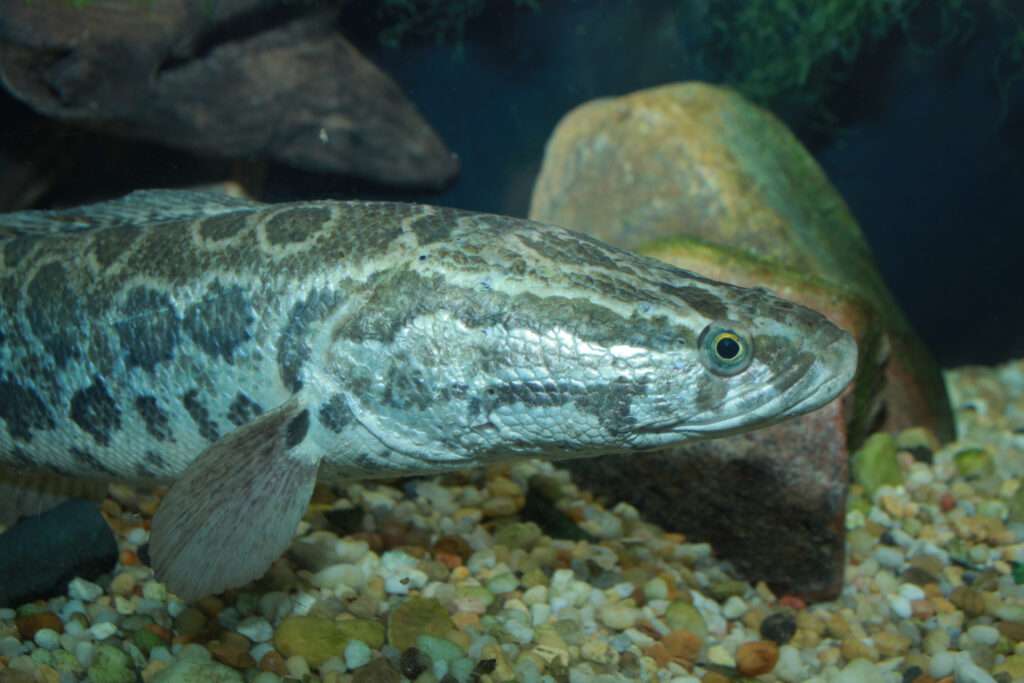
Size
3 feet
Physical Characteristics
All snakeheads share an elongated fusiform body that is slightly flattened closer to the fish tail. The fish’s dorsal and anal fins have soft rays and are well-developed. Both fins follow the fish’s body all the way to the tail stem. The pectoral fins of the fish are small and rounded, whereas the fish fluke is broad and circular. They have a big, somewhat flattened head that is almost entirely covered in scales. The numerous tiny setaceous teeth in its jaws are arranged in several rows.
Temperament
To varying degrees, the fish in this family are territorial and aggressive. They look frightening mostly due to their size and are vicious predators. Using their suprabranchial organs, they breathe, and they also breathe through the air around them.
Habitat
The freshwater perciform fish family Channidae, which includes the snakeheads, is native to regions of Africa and Asia. Snakehead fish tend to live in swamps, slow-moving streams, and shallow ponds with lots of vegetation and muddy bottoms. They can also be discovered in rivers, lakes, canals, and reservoirs.
Keeping as Pet

- Tank Size
They would require a tank that is at least 20 to 30 gallons in size, and that too for small to medium-sized fish. You can choose larger tanks for fish that are larger. The size can increase and range from 55 to 240 gallons. Such fish are frequently petted by professional breeders in their ponds.
- Water Conditions
Given the diversity of the species, some are at their most comfortable at 9 degrees Celsius, while others like 20 degrees. Even some fish can survive in temperatures that are nearly 40 degrees Celsius.
The majority of the species demand a typical pH range of 6-7. Some species require water that has a pH of 2. Some fish will require a pH level of about 8. In the end, this is species-specific, and aside from those already stated, there aren’t many other exceptions.
We are providing a range of general hardness for the complete family of Snakehead fishes because the water hardness is also unique to each species. There is nothing available above that level and they only require 5 to 20 dGH.
- Feeding
There are unique challenges to feeding in a tank. You need to feed some particular fish species in addition to simply sprinkling food over the water’s surface of the tank. Depending on the type and size, you can use your fingers or pincers to do the task. Although the majority of the species are omnivorous, it is best to feed them insects and their larvae. Crickets, mealworms, and earthworms are all avidly consumed by the fish.
Though artificial food, meat that contains one, pellets, or sticks work just as well, you can train snakeheads to eat meat, shellfish, and shrimp. The fact that the fish won’t consume tank plants or any other flora can be seen as a benefit.
- Tank mates
Since most of these fish species exhibit predatory tendencies, tanks are used to house them. Yet, if you work at it, you can effectively maintain snakeheads in a communal tank.
The size of the fish should be your first priority. The majority of snakehead fish varieties make suitable aquarium companions for other large-sized fish species. Naturally, keeping small neon tetra or guppy fish together would be unsafe since the fish will treat them as food.
Since the fish won’t be able to ingest any of them and will subsequently suffocate to death, keeping snakeheads alongside little catfish or loaches is not at all an option. Most species of average size will do well in tanks with active, undemanding fish types. These could be KOI-type large- and medium-sized carp. Despite their predatory tendencies, little snakeheads are timid and readily destroyed by large, hostile cichlids (for example, flowerhorn).
Table





